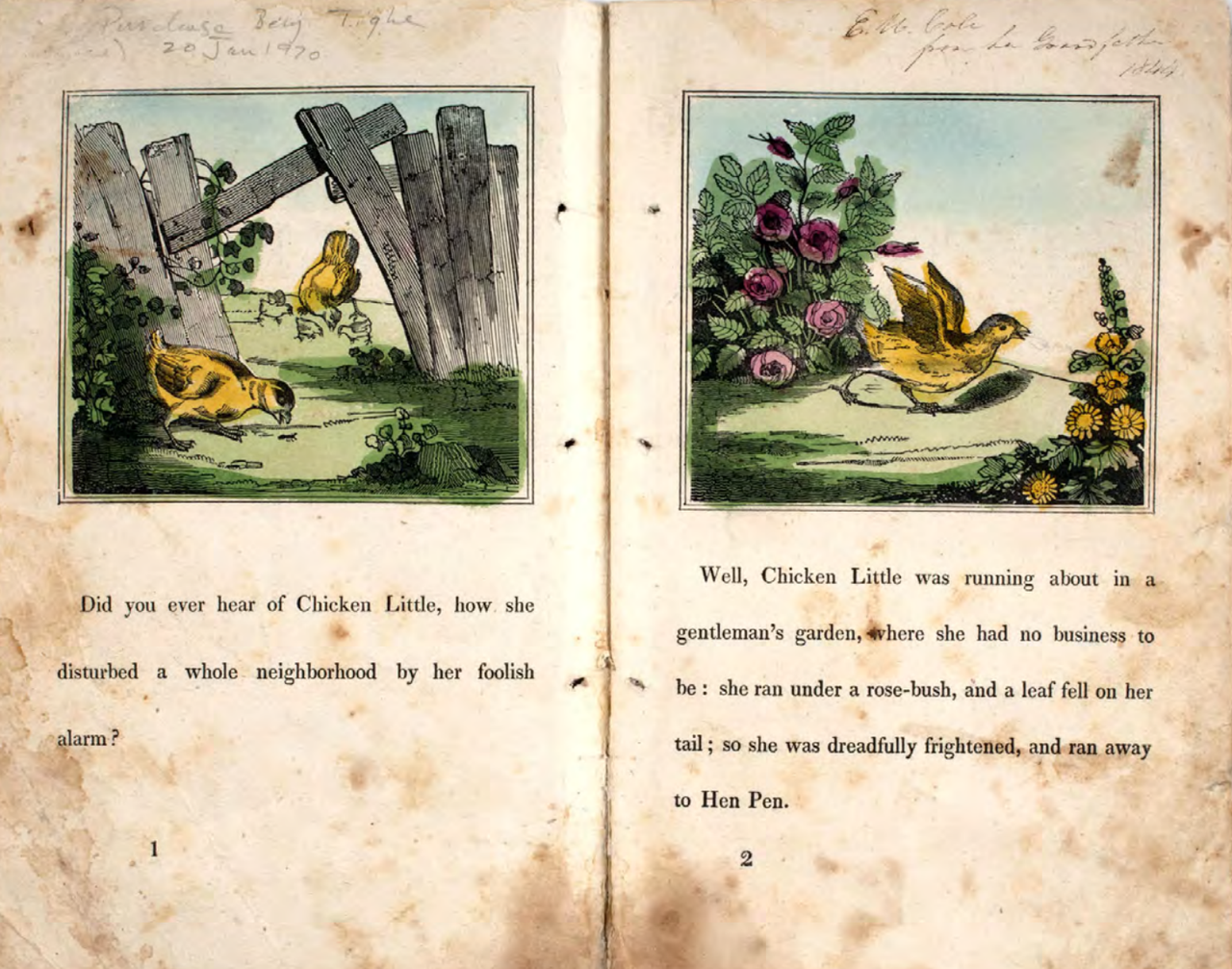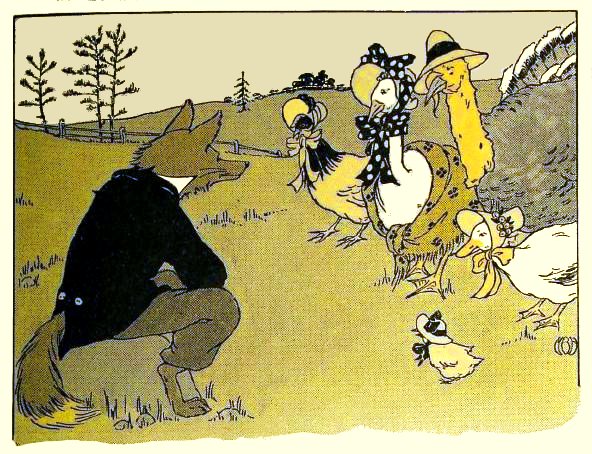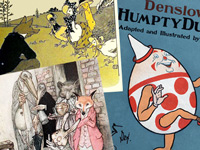Chicken Little (Henny Penny)

Henny Penny, more commonly known in the United States as Chicken Little and sometimes as Chicken Licken, is a folk tale with a moral in the form of a cumulative tale about a chicken who believes the world is coming to an end. The phrase "The sky is falling!" features prominently in the story, and has passed into the English language as a common idiom indicating a hysterical or mistaken belief that disaster is imminent. Versions of the story go back more than 25 centuries; it continues to be referenced in a variety of media.
The story and its name
The story is listed as Aarne-Thompson-Uther type 20C, which includes international examples of folktales that make light of paranoia and mass hysteria. There are several Western versions of the story, of which the best-known concerns a chick that believes the sky is falling when an acorn falls on its head. The chick decides to tell the King and on its journey meets other animals (mostly other fowl) which join it in the quest. After this point, there are many endings. In the most familiar, a fox invites them to its lair and there eats them all. Alternatively, the last one, usually Cocky Lockey, survives long enough to warn the chick, who escapes. In others all are rescued and finally speak to the King.
In most retellings, the animals have rhyming names, commonly Chicken Licken or Chicken Little, Henny Penny or Hen-Len, Cocky Locky, Ducky Lucky or Ducky Daddles, Drakey Lakey, Goosey Loosey or Goosey Poosey, Gander Lander, Turkey Lurkey and Foxy Loxy or Foxy Woxy.
The moral to be drawn changes, depending on the version. Where there is a "happy ending", the moral is not to be a "Chicken" but to have courage. In other versions where the birds are eaten by the fox, the fable is interpreted as a warning not to believe everything one is told.
In the United States, the most common name for the story is "Chicken Little", as attested by illustrated books for children dating from the early 19th century. In Britain and its other former colonies, it is best known as "Henny Penny" and "Chicken Licken", titles by which it also went in the United States.

First two pages of the 1840 children's illustrated book: The Remarkable Story of Chicken Little

First two pages of the 1840 children's illustrated book: The Remarkable Story of Chicken Little
( Click image to enlarge)
History
The story was part of the oral folk tradition and only began to appear in print after the Brothers Grimm had set a European example with their collection of German tales in the early years of the 19th century. One of the earliest to collect tales from Scandinavian sources was Just Mathias Thiele, who in 1823 published an early version of the Henny Penny story in the Danish language. The names of the characters there are Kylling Kluk, Høne Pøne, Hane Pane, And Svand, Gaase Paase, and Ræv Skræv. In Thiele's untitled account, a nut falls on Kylling Kluk's back and knocks him over. He then goes to each of the other characters, proclaiming that “I think all the world is falling” and setting them all running. The fox Ræv Skræv joins in the flight and, when they reach the wood, counts them over from behind and eats them one by one. Eventually the tale was translated into English by Benjamin Thorpe after several other versions had appeared.
Once the story began to appear in the English language, the titles by which they went varied considerably and have continued to do so. John Greene Chandler (1815-1879), an illustrator and wood engraver from Petersham, Massachusetts, published an illustrated children's book titled The Remarkable Story of Chicken Little in 1840. In this American version of the story, the characters' names are Chicken Little, Hen-Pen, Duck-Luck, Goose-Loose, and Fox-Lox; Chicken Little is frightened by a leaf falling on her tail.
A Scots version of the tale is found in Robert Chambers's Popular Rhymes, Fireside Stories, and Amusements of Scotland of 1842. It appeared among the "Fireside Nursery Stories" and was titled "The hen and her fellow travellers". The characters included Henny Penny, Cocky Locky, Ducky Daddles, Goosie Poosie, and an unnamed "tod" (fox). Henny Penny became convinced that "the lifts were faun" (the heavens were falling) when a pea fell on her head.
In 1849, a "very different" English version was published under the title "The Story of Chicken-Licken" by Joseph Orchard Halliwell. In this Chicken-licken was startled when "an acorn fell on her bald pate" and encounters the characters Hen-len, Cock-lock, Duck-luck, Drake-lake, Goose-loose, Gander-lander, Turkey-lurkey and Fox-lox.
It was followed in 1850 by “The wonderful story of Henny Penny” in Joseph Cundall's compilation, The Treasury of pleasure books for young children. Each story there is presented as if it were a separate book, and in this case had two illustrations by Harrison Weir. In reality the story is a repetition of the Chambers narration in standard English, except that the dialect phrase "so she gaed, and she gaed, and she gaed" is retained and the cause of panic is mistranslated as "the clouds are falling".
Benjamin Thorpe's translation of Thiele's Danish story was published in 1853 and given the title "The Little Chicken Kluk and his companions". Thorpe describes the tale there as “a pendant to the Scottish story…printed in Chambers” (see above) and gives the characters approximately the same names as in Chambers.
Comparing the different versions, we find that in the Scots and English stories the animals want "to tell the king" that the skies are falling; while in the American story, as in the Danish, they are not given any specific motivation. In all versions they are eaten by the fox, although in different circumstances.
LITERATURE FAIRY TALES

An illustration from the story Chicken Little in the New Barnes Reader vol.1, New York, 1916

An illustration from the story Chicken Little in the New Barnes Reader vol.1, New York, 1916
( Click image to enlarge)
A fairy tale is a type of short story that typically features folkloric fantasy characters, such as dwarves, elves, fairies, giants, gnomes, goblins, mermaids, trolls, or witches, and usually magic or enchantments. Fairy tales may be distinguished from other folk narratives such as legends (which generally involve belief in the veracity of the events described) and explicitly moral tales, including beast fables. The term is mainly used for stories with origins in European tradition and, at least in recent centuries, mostly relates to children's literature.
Read More » List of Fairy tales »
RESOURCES
This article uses material from the Wikipedia articles "List of fairy tales", "Fairy tale" and "Henny Penny", which is released under the Creative Commons Attribution-Share-Alike License 3.0.
© Stories Preschool. All Rights Reserved.





